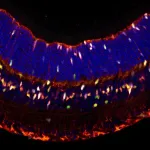USC Stem Cell mouse study identifies shared genes involved in hearing and vision regeneration
2025-03-31
(Press-News.org)
The same genes could hold the key to regenerating cells in the ear and eye, according to a new mouse study from the USC Stem Cell laboratory of Ksenia Gnedeva, PhD, published in the Proceedings of the National Academy of Sciences (PNAS).
“The proliferation of progenitor cells in response to injury is a crucial step in the regeneration of sensory receptors, but this process is blocked in the mammalian inner ear and retina. By understanding the genes that enforce this block, we can advance efforts to restore hearing and vision in patients,” said Gnedeva, an assistant professor in the USC Tina and Rick Caruso Department of Otolaryngology – Head and Neck Surgery, and the Department of Stem Cell Biology and Regenerative Medicine at the Keck School of Medicine of USC.
In the study, first authors Eva Jahanshir and Juan Llamas from the Gnedeva lab focused on a group of interacting genes called the Hippo pathway, which serve as a “stop growing” signal that the lab has shown to inhibit cell proliferation in the ear during embryonic development. In their experiments, the scientists demonstrated that the Hippo pathway also suppresses the regeneration of damaged sensory receptors in the ear and eye of adult mice.
The scientists used an experimental compound that the lab earlier developed to inhibit a key protein in the Hippo pathway: Lats1/2. When exposed to this drug-like compound in a Petri dish, the progenitor cells known as supporting cells responded by proliferating in the utricle, which is a sensory organ in the inner ear that helps with balance. However, the same cells did not respond in the organ of Corti, which is the hearing sensory organ.
The scientists next identified what was blocking this important step towards sensory cell regeneration in the organ of Corti — a gene encoding a protein called p27Kip1 — and showed that this inhibitory protein was also high in the retina. They created a transgenic mouse in which the level of p27Kip1 could be reduced in the inner ear and the retina to see how that would impact the proliferation of progenitor cells in response in both organs.
In these mice, inhibiting the Hippo pathway effectively caused supporting cells proliferation in the organ of Corti, an important step towards the regeneration of the ear’s sensory cells. In the retina, inhibiting the Hippo pathway induced the proliferation of progenitor cells known as Müller glia. Surprisingly, the researchers discovered that some of the Müller glia progeny, without further manipulation, converted to sensory photoreceptors and other neuronal cell types in the retina.
“There have been reports that p27Kip1 levels drop following injury, so that might offer a brief window of opportunity for using a drug-like compound to inhibit the Hippo pathway and encourage regeneration in the ear and the eye,” said Gnedeva. “Alternatively, it could be possible to develop another drug-like compound to reduce p27Kip1 levels. So, our discoveries have identified potential new targets for stimulating the regeneration of both hearing and vision.”
Additional co-authors are Yeeun Kim, Kevin Biju, and Sanyukta Oak from the Gnedeva Lab.
This work was supported by federal funding from the National Institutes of Health’s National Institute on Deafness and Other Communication Disorders (grant 1R01DC020268, training grant T32DC009975, and clinician-scientist training grant 5R25DC019700).
Disclosures
Gnedeva is a co-inventor on three patent applications related to this work: 1. Lats kinase inhibitor to treat retinal degeneration (PCT application number PCT/US2024/023146; U.S. Patent and Trademark serial number usc0282prv); 2. Pyrrolopyridine-3- and 4-carboxamide compositions and methods for cellular proliferation (docket number 2877.035P1); and 3. Pyrrolo[2,3-b]pyridine-3-carboxamide compositions and methods for ameliorating hearing loss (application number 62970425).
END
[Attachments] See images for this press release:

ELSE PRESS RELEASES FROM THIS DATE:
2025-03-31
A new study published in Proceedings of the National Academy of Sciences (PNAS) has turned traditional thinking on its head by highlighting the role of human interactions during the shift from hunting and gathering to farming - one of the biggest changes in human history - rather than earlier ideas that focused on environmental factors.
The transition from a hunter-gatherer foraging lifestyle, which humanity had followed for hundreds of thousands of years, to a settled farming one about 12,000 years ago has been widely discussed in popular books like Sapiens: A Brief History of Humankind by Yuval Noah Harari.
Researchers from the University of Bath, the Max Planck Institute ...
2025-03-31
International scientists have uncovered the oldest known phosphatic stromatoporoid sponge, dating back approximately 480 million years to the Early Ordovician, in South China.
Stromatoporoid sponges were key reef builders during the Palaeozoic era, playing a crucial role in constructing biological frameworks—similar to the role of modern corals. They were especially important during the middle Paleozoic era (from the late Middle Ordovician to Devonian), a time marked by a major transition from microbial-dominated to skeletal-dominated reef ecosystems. Previously, stromatoporoid ...
2025-03-31
New York, NY [March 31, 2025] — Brian Brown, PhD, Director of the Icahn Genomics Institute at the Icahn School of Medicine at Mount Sinai, has been elected to the College of Fellows of the American Institute for Medical and Biological Engineering (AIMBE). He was honored for his seminal work in gene therapy and functional genomics, which has helped transform the fields and contributed to key advancements in medicine and biotechnology.
Election to the AIMBE College of Fellows is one of the highest professional distinctions in the field. It recognizes the ...
2025-03-31
Mental health care can be difficult to access in the U.S. Insurance coverage is spotty and there aren’t enough mental health professionals to cover the nation’s need, leading to long waits and costly care.
Enter artificial intelligence (AI).
AI mental health apps, ranging from mood trackers to chatbots that mimic human therapists, are proliferating on the market. While they may offer a cheap and accessible way to fill the gaps in our system, there are ethical concerns about overreliance on ...
2025-03-31
Rice University researchers have developed an innovative solution to a pressing environmental challenge: removing and destroying per- and polyfluoroalkyl substances (PFAS), commonly called “forever chemicals.” A study led byJames Tour, the T.T. and W.F. Chao Professor of Chemistry and professor of materials science and nanoengineering, and graduate student Phelecia Scotland unveils a method that not only eliminates PFAS from water systems but also transforms waste into high-value graphene, offering a cost-effective and sustainable approach to environmental remediation. This research was published March 31 in Nature Water.
PFAS ...
2025-03-31
Lack of sleep and stress hinder athletic performance, but some athletes may be better at performing competitively despite sleep issues and stress. In a new JNeurosci paper, researchers led by Yan Sun, from Peking University, looked for predictive behavioral and neural markers in athletes who maintain their performance level following sleep deprivation and under stress.
The researchers assessed college and professional athletes’ stress levels and cognitive changes after 24 h of sleep deprivation, then followed their ...
2025-03-31
The comorbidity of binge eating and alcohol binge drinking is prevalent and increases the risk of other neuropsychiatric and bodily conditions. However, the mechanisms linking these forms of binge consumption are unclear. To explore the link between binge eating and binge drinking alcohol, Karen Szumlinski, from the University of California, Santa Barbara, and colleagues developed a way to model the disease comorbidity in mice. As reported in their JNeurosci paper, this mouse model led to the discovery that females with a history of binge eating start binge drinking ...
2025-03-31
People breathing contaminated air over the course of years are at greater risk of developing numerous diseases. This is thought to be due to highly reactive components in particulate matter, which affect biological processes in the body. However, researchers from the University of Basel, Switzerland, have now shown that precisely these components disappear within hours and that previous measurements therefore completely underestimate the quantities in which they are present.
From chronic respiratory problems to cardiovascular diseases, ...
2025-03-31
The wellbeing of Americans and the country’s longstanding position as a world leader in science and technology are in jeopardy due to the actions of the Trump administration, approximately 1,900 leading figures in medicine, science, and engineering warn today in an open statement to the American public. The list of signatories includes Nobel Prize winners, deans of medical schools, and national leaders in science and technology.
“For over 80 years, wise investments by the US government have built up the nation’s research enterprise, making it the envy of ...
2025-03-31
About The Study: Although Canada is not the largest supplier of medications to the U.S., tariffs could raise costs and strain supply chains. This study estimates that $3 billion in U.S. pharmaceuticals depend on Canadian manufacturing, with 25% tariffs adding $750 million in cost. Although the Inflation Reduction Act provisions limit cost pass-through to some payers (i.e., Medicare), manufacturers may still adjust production or alter distribution, increasing supply chain fragility.
Corresponding Author: To contact the corresponding author, Mina Tadrous, PharmD, PhD, email mina.tadrous@utoronto.ca.
To access the embargoed study: Visit our For The Media website ...
LAST 30 PRESS RELEASES:
[Press-News.org] USC Stem Cell mouse study identifies shared genes involved in hearing and vision regeneration

